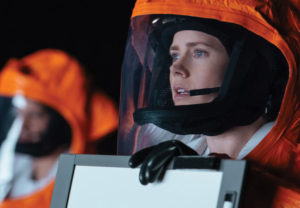By Vanessa Chen || Staff Writer

As people living in a culture saturated with moving images, we have all acquired a degree of fluency in the language of film. Part of what got people buzzing about the film Arrival is how it subverts our knowledge of the way films are supposed to “work.”
Arrival is a 2016 film directed by Denis Villeneuve and stars Amy Adams as Professor Louise Banks–a linguist who is tasked with making first contact with the aliens and deciphering their language. The film starts with a montage of Louise Banks narrating over the birth, life, and death of her daughter. Within the first 30 seconds or so we have already formed a lot of assumptions. We assume that she is the protagonist since she appears first. We assume that she is the one doing the voiceover (which further solidifies her as the protagonist). And we assume that she was a mother whose daughter had passed away.
We also base the film’s timeline on the first montage. We know that a montage compresses time, so we understand it as fragments of events happening in order, instead of our protagonist interacting with a baby, then a little girl, then a teenager. As an audience we are exposed to flashbacks much more than flashforwards, so we are prone to assume that what happened in the montage happened in the past, and the rest of the movie will happen in the present. Based on the information provided by the montage, and our knowledge of the sci-fi genre, we subconsciously map out how the movie will progress and end–a mother will resolve a crisis with aliens while moving on from the death of her daughter.
All of these cues packed into 30 seconds!
Without explicit confirmation, our brains piece together so much information. And we don’t start doubting the timeline we have set up in our minds until the movie challenges it more than half way through. The movie provides a hint in the starting montage where Louise says: “But now I’m not sure I believe in beginnings and endings.” However, we are so habitual in our recognition of cues that most audiences, including me, ignore the hint completely.
In fact, films nowadays seldom challenges our assumptions. Many film are so predictable that we are routinely proven right and then bored. Even if a film produces a plot twist, it is not usually done in a “new” way. Information is often withheld through storytelling–such as “the butler is the murderer” or “the police come out of nowhere to help just as the hero is about to die.”
But the plot twist of Arrival is truly unique and gratifying because it engages the audience with the film media in a way that few commercial films ever do. When we realize that our preconceived notions are wrong, we recognize how the film has set us up for it.
To explain what I mean let’s first look to the short story from which the movie adapted– Ted Chiang’s The Story of Your Life. Chiang does something interesting in writing–he mixes tenses so a sentence can have past, present, and/or future tenses at the same time. There is no plot twist like in the movie. The English language cannot escape the bondage of grammar but the language of visual communication can transcend this limitation.
Arrival is an exploration of the film media as a unique storytelling device different from words. In the age of Hollywood movie making, the mechanics of filmmaking is always hidden. Hollywood values continuity, clarity, and visual stimulation. It wants to create a viewing experience so engulfing that the audience almost forget they are watching a movie. The result is that most audiences think of the film as a mere visual illustration of spoken/written words.
But Arrival examines the language of the film, much like how Louise Banks examines the alien language. Arrival engages the mass audience to rethink how they perceive a film and it encourages them to see the potential of film as a unique media and art form.
Sophomore Vanessa Chen is a staff writer. Her email is wchen1@fandm.edu.